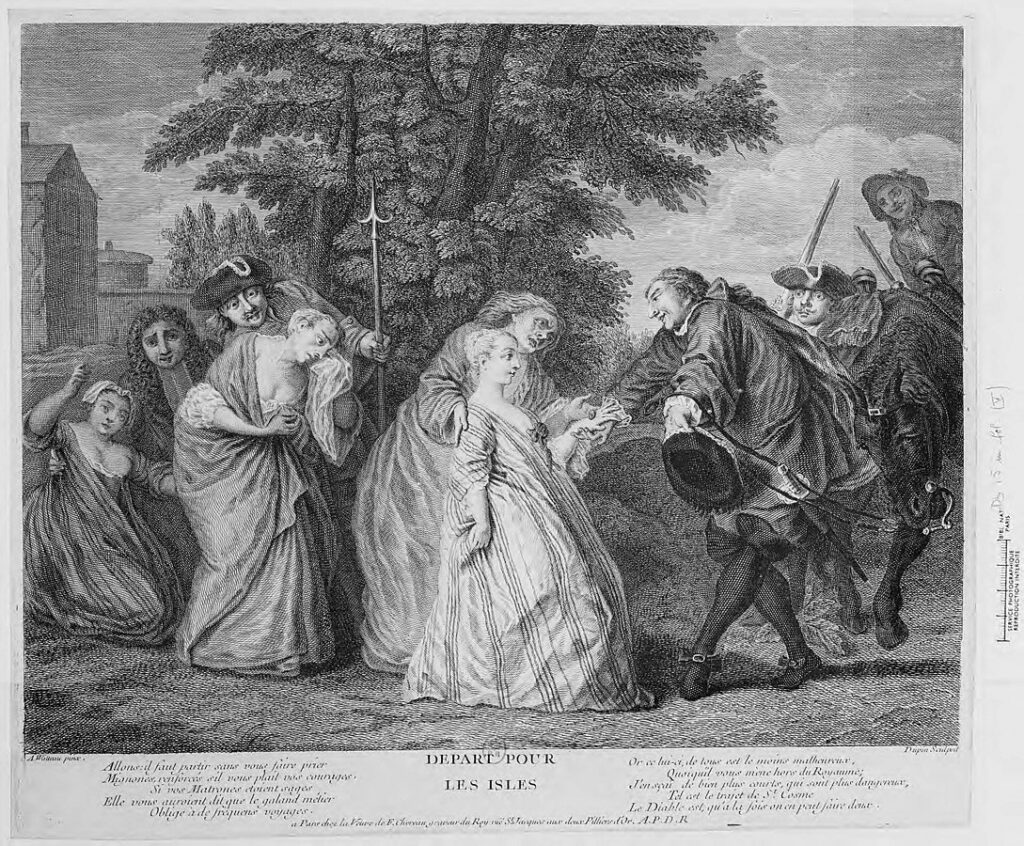
After Watteau. The departure of the comfort women for the American isles. Bibliothèque nationale de France.
Full Name: Casquette Girls
Date: Existed from 1704-28
Location: Ship Island, Mississippi
Monument Type: Historic/Residence
Photograph Caption/Credit: Watteau, Public domain, via Wikimedia Commons
When the French began colonizing North America in the early 1700s, they lacked women. A major colony was the Louisiana colony, which also contained Mississippi and Alabama. The colony was first settled by less than a hundred people, all males. As there were no French women to be with, some men turned to Native American women for companionship. The colonial French clergy did not like this happening. They feared that the men would break away from their Catholic roots when they were with their lovers. The clergy were also concerned that their mission to spread their faith to the New World would fail without Catholic French women to raise Catholic French families. The colonial governor, Jean Baptiste Le Moyne de Bienville also had concerns. If war broke out between the Natives and the French, would the colonists support their lovers or countrymen?
To fix these concerns, the colonial government and clergy requested imprisoned women and sex workers be sent from port cities to become wives. When the women proved to be bad wives, the government requested aid from King Louis XIV. Thus began the process of sending Frenchwomen to the colony to marry the male colonists.
The first women who traveled to the colonies were called “Pelican Girls,” named after the ship they arrived on (gonola.com). The 23 Pelican Girls had volunteered to make the journey to the New World, arriving in Mobile in 1704. The youngest was only fourteen years old. The girls were also able to choose which colonist they would marry. But, the colony the girls arrived in was not like the colony they were promised. They were not used to the heat and humidity. They did not like the unfinished colonial houses. They especially did not like having absent husbands who worked as traders and continued to see Native women. To change their new lives, the Pelican Girls launched a “Petticoat Rebellion” (countryroadsmagazine.com). They refused to care for their households and husbands until the men proved themselves as husbands and as colonists. This “Rebellion” worked, although the governor did not like the fuss the women created. In the future, he requested that women sent to the colonies were less domestic and more open to hard work.
Even though the Pelican Girls were able to shape up their men, the ship also brought over yellow fever. This caused deaths among the brides and lowered the population. More women reached Biloxi in 1719, and yet more came to New Orleans in 1728. Compared to the Pelican Girls, these girls led more scandalous lives back home in France. They lived in orphanages, poor houses, and prisons or were cast out by their families. These women brought over small cassettes, or suitcases, to carry their belongings. These cassettes became known as “casquettes” and then “caskets,” which is why these girls are known as “Casket Girls” (gonola.com). The journey across the Atlantic took months. Some of the girls were even chained together during their travels. To support the girls, a group of nuns traveled to the colony in 1727. They educated and cared for the girls until their marriages. Even though the Casket Girls often had no say when they were taken from France, they helped make Louisiana a strong colony. They helped to expand the colony’s population and create a new, unique Louisiana culture.
Sources
https://wams.nyhistory.org/settler-colonialism-and-revolution/settler-colonialism/casket-girls/
https://gonola.com/things-to-do-in-new-orleans/history/the-casket-girls-wives-for-french-new-orleans
https://allthatsinteresting.com/casket-girls
https://countryroadsmagazine.com/art-and-culture/history/a-shortage-of-women/
